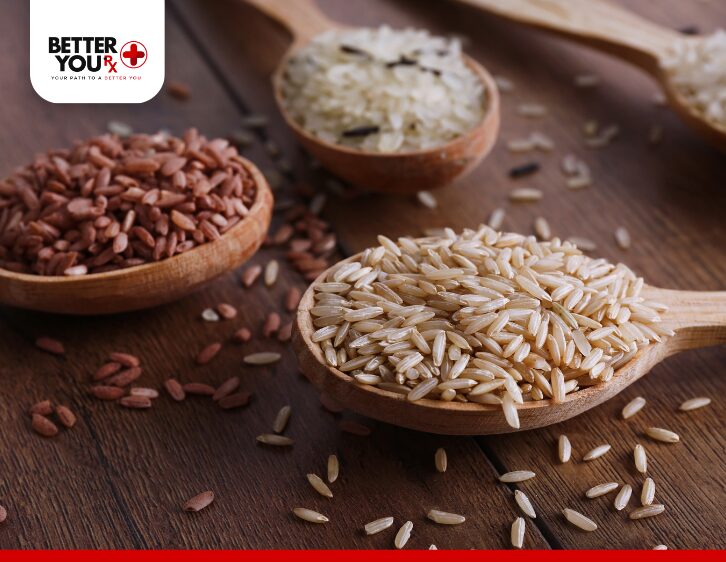When managing diabetes, one common question is whether rice is a good or bad food choice. Given its status as a staple in many diets, it’s also natural to wonder whether brown rice or white rice is the better option. Let’s dive into the details to understand the impact of these grains on blood sugar levels.
Different Types of Rice

The type of rice you choose can significantly affect its nutritional value. While both brown and white rice are carbohydrate-rich foods, their processing and nutritional content differ greatly.
White Rice is a highly processed grain. During the refining process, the bran, germ, and husk are removed, leaving behind a grain that is lower in essential nutrients like vitamins and minerals. After processing, white rice contains negligible amounts of vitamins and a low level of minerals.
In contrast, Brown Rice is a whole grain. It retains the bran, germ, and husk, making it a more nutrient-dense option. Brown rice provides important vitamins like niacin, folate, and choline, along with minerals such as calcium, magnesium, phosphorus, potassium, and selenium.
When it comes to fiber, white rice contains about 0.6 grams per half-cup serving, while brown rice offers a more substantial 1.8 grams of dietary fiber per the same portion size.
White Rice vs. Brown Rice: Nutritional Comparison
While brown rice offers more nutritional benefits than white rice, there’s a significant consideration for people with diabetes: both types of rice are high in carbohydrates. A half-cup serving of brown rice contains about 22.4 grams of carbs, and after factoring in fiber, the net carbs are approximately 21 grams. While this may seem like a modest serving, many people consume much larger portions, which can significantly impact blood sugar levels.
Carbohydrates are the main nutrient influencing blood sugar and A1c levels. For individuals managing diabetes, consuming too many carbs—especially from rice—can cause blood sugar spikes.
The Glycemic Index of Rice

The Glycemic Index (GI) indicates how rapidly a food increases blood sugar levels. Foods with a GI of 55 or below are considered low GI, while those above 55 are high GI.
Here’s how different types of rice rank on the GI scale:
- White rice: 70
- Jasmine rice: 70
- Rice milk: 85
- Basmati rice: 45-50
- Brown rice: 50
- Wild rice: 35
As you can see, wild rice has the lowest GI, followed by brown rice, making them better options for managing blood sugar.
Carb Content in Rice and Rice Products
It’s essential to consider the carbohydrate content in various rice products. Here’s a breakdown of common rice and rice-related foods:
- Basmati rice (1 cup cooked): 39.8 g carbs
- Jasmine rice (3/4 cup cooked): 36 g carbs
- Wild rice (1 cup cooked): 35 g carbs
- Black rice (1/2 cup cooked): 34 g carbs
- Red rice (1 cup cooked): 45 g carbs
- White rice flour (1/2 cup): 63.3 g carbs
- Brown rice flour (1/2 cup): 60.4 g carbs
- Rice cakes (1 plain): 7 g carbs (with zero fiber)
- Rice milk (1/2 cup): 11.5 g carbs
As you can see, rice products are predominantly carbohydrate-rich, with minimal fiber content, making them less than ideal for diabetes management.
Fiber and Its Role in Diabetes
Whole grains like rice are often recommended for their fiber content, but there are many lower-carb, high-fiber foods that won’t negatively impact blood sugar. Here are a few options:
- Avocado (1/2): 7 g fiber
- Broccoli (1 cup): 2.4 g fiber
- Chia seeds (1 tbsp): 5.5 g fiber
- Walnuts (1 oz): 1.9 g fiber
- Raspberries (1/4 cup): 2.9 g fiber
- Carrot (1 medium): 1.7 g fiber
- Coconut (1/4 cup): 1.5 g fiber
Incorporating these fiber-rich, low-carb foods can help you meet your daily fiber needs while maintaining stable blood sugar levels.
Research on Rice and Diabetes
Studies have shown that consuming whole grains like brown rice may lower the risk of developing type 2 diabetes. However, once someone is diagnosed with diabetes, whole grains do not appear to improve blood sugar control. The American Diabetes Association’s 2017 guidelines state that “whole-grain consumption is not associated with improvements in glycemic control in type 2 diabetes.”
While brown rice may cause a smaller spike in blood glucose than white rice, it is still a high-carb food that can lead to an increase in blood sugar levels when consumed in large quantities. Furthermore, research suggests that low-carb diets are more effective for managing blood sugar and improving A1c levels than diets high in carbs, including whole grains.
One study found that participants on a low-carb diet for six months had a more significant improvement in A1c levels compared to those on a calorie-restricted diet. The low-carb group also showed improvements in triglyceride levels, weight loss, and reduction in medication use.
Diabetes-Friendly Rice Alternatives

If you’re looking to avoid rice but still enjoy dishes like stir-fries, there are plenty of great rice alternatives. Cauliflower rice is an excellent substitute that provides the texture and versatility of rice without the carbs. You can use it in dishes like Chicken Massaman Curry, offering a delicious and blood sugar-friendly option.
Conclusion: Is Rice Good for Diabetics?
While whole grains like brown rice may offer some benefits in terms of diabetes risk reduction, they are not recommended for blood sugar management once diabetes or prediabetes is diagnosed. Brown rice is a better choice than white rice due to its higher fiber and nutrient content, but it should still be consumed in moderation due to its high carbohydrate content.
Ultimately, rice is a starchy food that can lead to elevated blood sugar and A1c levels, and it’s best to minimize or avoid it in your diet. Instead, focus on non-starchy vegetables and lower-carb options to help manage blood sugar effectively.
If you’re looking for further guidance on managing diabetes through diet, consider joining our community. We offer meal plans, resources, and support to help you take control of your health and manage your diabetes effectively.
For more tips and resources to manage diabetes, visit Better You Rx today, your trusted pharmacy partner for lifestyle solutions.



